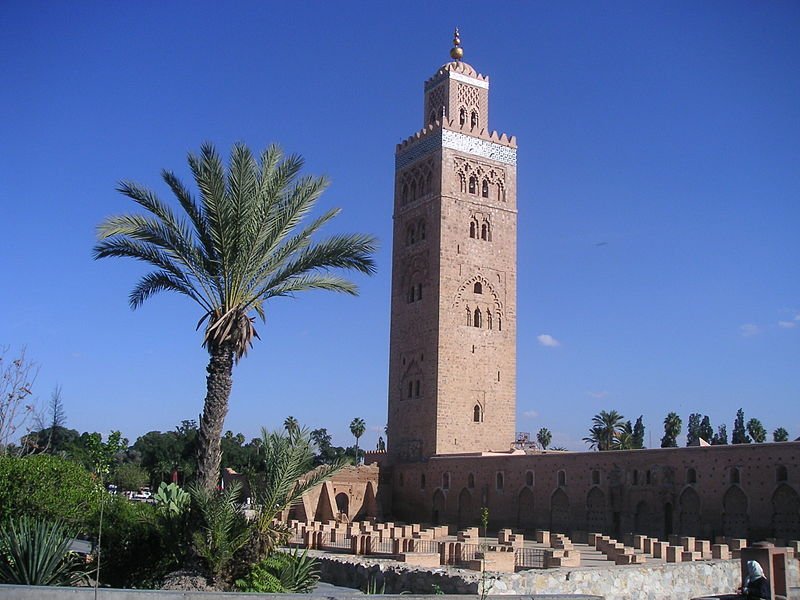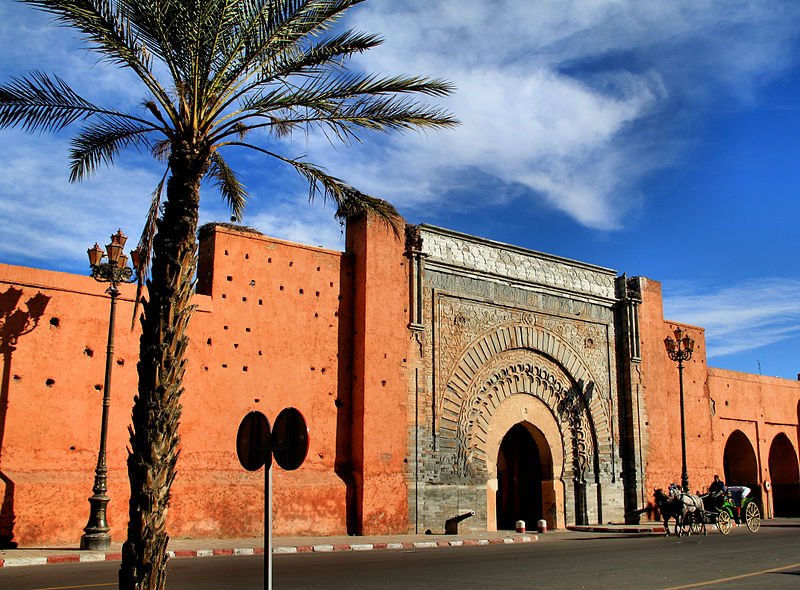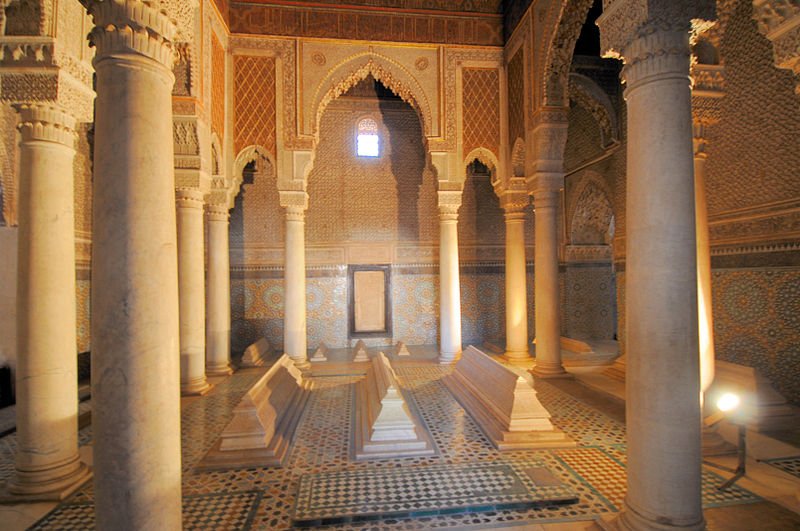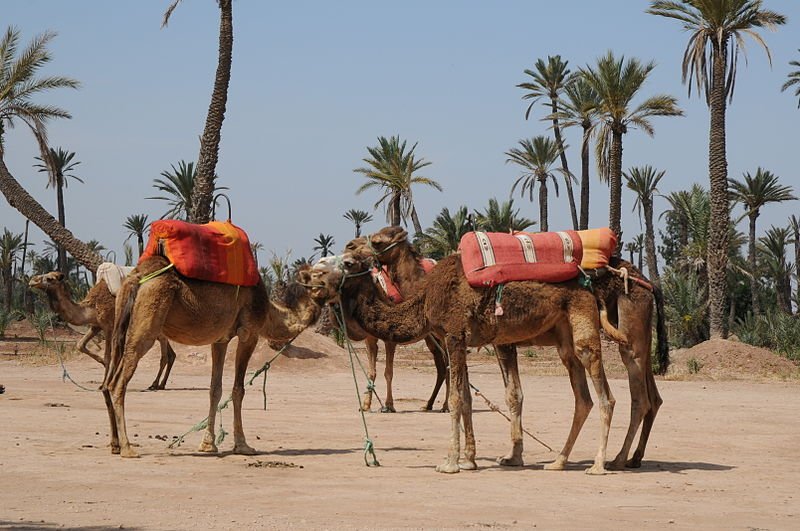Marrakesh (مراكش, French: Marrakech) is the second largest city in Morocco. Often called the Red City, it is an important former imperial city and presently the capital of the Marrakech-Tensift-Al Haouz region. The city has a population exceeding one million people (2011 estimate). Its old city, the Medina of Marrakesh, is today a World Heritage Site.
The name Marrakesh means "land of God". It is from the name of this city that the European form "Morocco" was derived. Indeed, in earlier times, the city itself was known as Marocco. It was only in 1911, following the Treaty of Fez, that Marrakesh denotes the city while Morocco denotes the country under French protectorate. A separation between the name for Marrakesh and Morocco came about during the reign of Mohammed Ben Aarafa, when the city became known in Arabic as al-Mamlaka al-Magribiyya, meaning the Western Kingdom.
The city of Marrakesh is located at the foot of the High Atlas, the highest mountain range in North Africa. To the south of the city stretch the shrublands that graduate into the Sahara desert while to the west the Atlantic Ocean. Marrakesh experiences a semi-arid climate with dry summers and wet winters. Hottest month is July, when the average high temperature reaches 36.8°C (98.2°F). Coldest month is January, when the average low drops to 5.9°C (42.6°F). Marrakesh receives only 281.3 mm (11 in) of rain in a year, with the wettest month being November, which receives 40.6 mm (1.6 in) of rainfall.
 Koutoubia Mosque, Marrakesh
Koutoubia Mosque, Marrakesh http://commons.wikimedia.org/wiki/File:Koutoubia_Mosque_1.jpg
http://commons.wikimedia.org/wiki/File:Koutoubia_Mosque_1.jpg BetacommandBot
BetacommandBot
 Bab Agnaou, Marrakesh
Bab Agnaou, Marrakesh http://commons.wikimedia.org/wiki/File:Marrakech_2009_Bab_Agnaou_Gate_LL.JPG
http://commons.wikimedia.org/wiki/File:Marrakech_2009_Bab_Agnaou_Gate_LL.JPG Lionel Leo
Lionel Leo
The area around Marrakesh has been inhabited for over a thousand years. Until the 11th century, the town was part of neighboring Aghmat. In 1070, the ruler of Aghmat, Abu-Bakr Ibn-Umar relocated his capital of Marrakesh to avoid the overcrowded Aghmat. The new capital was built beside the Tensift River.
Successive rulers turned Marrakesh into a center of intellectual scholarship. The Koutoubia Mosque was built during the rule of Yaqub al-Mansur, along with a new kasbah, or citadel. Marrakesh became the capital of Morocco until 1672, when Moulay Ismail relocated the capital to Meknes.
 Saadian tombs, Marrakesh
Saadian tombs, Marrakesh http://commons.wikimedia.org/wiki/File:Les_Tombeaux_Saadien_Ali_Ben_Youssef_01_Marrakch.JPG
http://commons.wikimedia.org/wiki/File:Les_Tombeaux_Saadien_Ali_Ben_Youssef_01_Marrakch.JPG Viault
Viault
Although not an administrative capital, Marrakesh continued to function as a center of religion, where the festival of seven saints were celebrated on a grand scale. The tombs of many Sufi Muslim saints are also located in the city.
Today Marrakesh is a bustling Moroccan city with the largest souq or traditional market in the world. The city provides tourist a kaleidoscopic view of Morocco from its food stalls, bazaar, mosques and architecture.
Visiting Marrakesh
The Marrakech-Menara Airport (RAK) is an international airport with direct flights from London, Paris and Madrid. Camels at La Palmeraie, Marrakesh
Camels at La Palmeraie, Marrakesh http://commons.wikimedia.org/wiki/File:La_Palmeraie_de_Marrakech_692.JPG
http://commons.wikimedia.org/wiki/File:La_Palmeraie_de_Marrakech_692.JPG Viault
Viault
Places of Interest in Marrakesh
The Medina of Marrakesh is a World Heritage Site of Morocco.- Aguedal Gardens
A historic garden and orchard created in the 12th century. It is within an enclosed area measuring 3 km by 1.5 km, and planted with various fruit trees. - Bab Agnaou
Monumental gate built by Yacoub el-Mansour to mark the entrance to his palace. - Bab Doukkala Mosque
Mid-16th century mosque built by the mother of the Saadian ruler, Ahmed el-Mansour. - Ben Youssef Madrasa
One of the biggest and finest Koranic schools in the Magreb, with a student body of 900. - Chrob ou Chouf Fountain
Literally the fountain of "drink and admire", this is one of the most beautiful fountains in the medina of Marrakesh. - Dar el-Makhzen
The royal palace built by Sisi Mohammed ben Abdallah in the 18th century, next to the ruins of Palais el-Badi. - Dar Si Saïd Museum
A modern museum housed in the late 19th century palace of Si Saïd ben Moussa showcasing various artifacts from intricate plasterwork to doors, carriages, carpets, pottery and more. - Guéliz
This is the new town of Marrakesh, built by the French after they made Morocco a protectorate in 1912. - Kasbah Mosque
Mosque with a distinctive minaret, built by Yacoub el-Mansour in the late 12th century. This is the only other surviving Almohad building, apart from the Koutoubia Mosque. - Koubba Ba'Adiyn
The only example of Almoravid architecture in Marrakesh, this was once part of a mosque that has since been demolished. - Koutoubia Mosque
One of the largest medieval mosques of the Western Muslim world, this was built by the Almohad Sultan Abd el-Moumen in 1147, following his victory over the Almoravids. - La Mamounia Hotel
The legendary hotel opened in 1923 is a blend of Art Deco architecture with Moorish elements. - La Palmeraie
The Palm Grove of Marrakesh, which legend says was created in the 11th century when the soldiers of Sultan Youssef ben Tachfine sat out the stones of the dates they were eating. - Majorelle Garden
A lovely garden within Guéliz had its beginnings when French painter Jacques Majorelle decided to build a Moorish villa in Marrakesh in 1923. - Méchouars of Marrakesh
These are the three large parade grounds around Dar el-Makhzen palace where royal ceremonies and processions are held. - Mellah
Until the country's independence, the Jewish quarter of Marrakesh was the biggest in Morocco. - Menara
The imperial garden from the 12th century covering almost 90 hectares, beautifully landscaped with pavilions and pools. - Mouassine Mosque
Mosque established by Sultan Moulay Abdallah between 1562 and 1573, built on the site of a former Jewish quarter. - Musée de Marrakech
Museum housed in the Dar Menebhi, the 19th century palace of the grand vizier of Sultan Moulay Mehdi Hassan. The museum displays a disparate collection of art objects. - Palais Bahia
Literally the Palace of the Favorite, this palace complex was built in the late 19th century comprising two different parts, built in two different phases. - Palais el-Badi
The grand palace of Ahmed el-Mansour, built to cement his position as ruler, after defeating the Portuguese in the Battle fo the Three Kings in 1578. - Place Jemaa el-Fna
The central square of Marrakesh, today a World Heritage Site, is alive with activity throughout the day, from the large morning market to the shops and open-air performances of the evening. - Ramparts of Marrakesh
Medieval fortification that encircle the medina of Marrakesh. - Saadian Tombs
These tombs represent some of the finest examples of Islamic architecture in Morocco. Although the necropolis dates to the 12th century, the tombs built between the 16th and 18th centuries. - Souq of Marrakesh
One of the biggest and most fascinating old bazaars of the Maghreb. - Zaouia of Sidi ben Slimane el-Jazouli
Medieval mausoleum to a venerated mystic who founded Moroccan Sufism in the 15th century. - Zaouia of Sidi bel Abbès
Mausoleum to Sidi bel Abbès, the 12th century patron saint of Marrakesh.
 Latest updates on Penang Travel Tips
Latest updates on Penang Travel Tips

Copyright © 2003-2025 Timothy Tye. All Rights Reserved.

 Go Back
Go Back